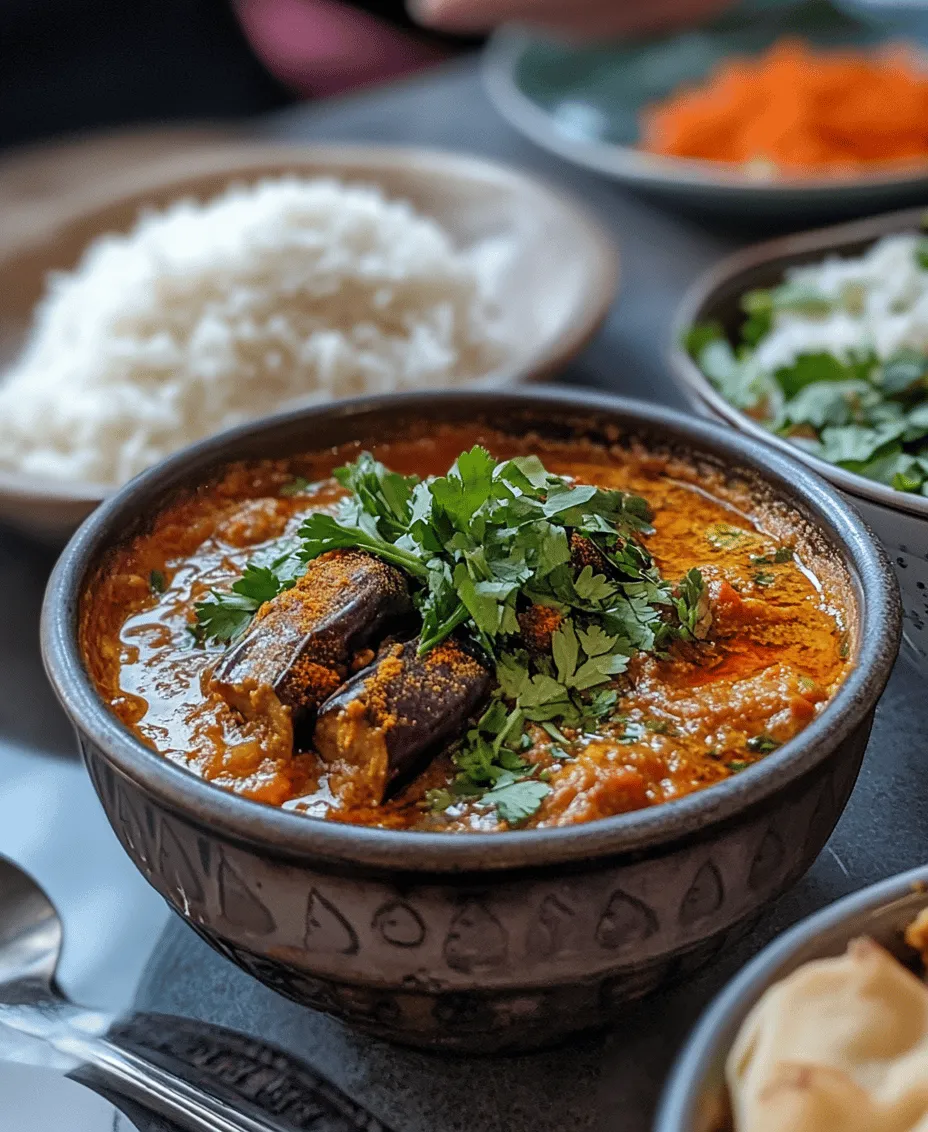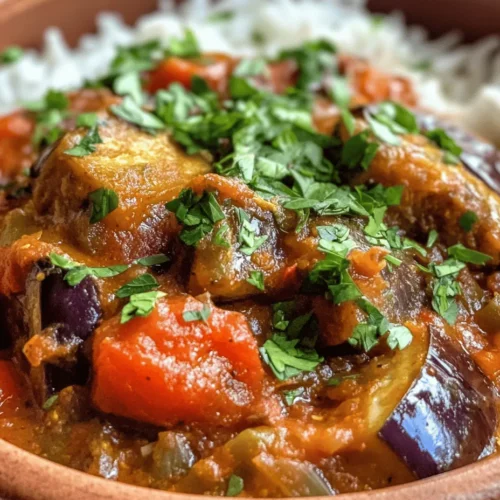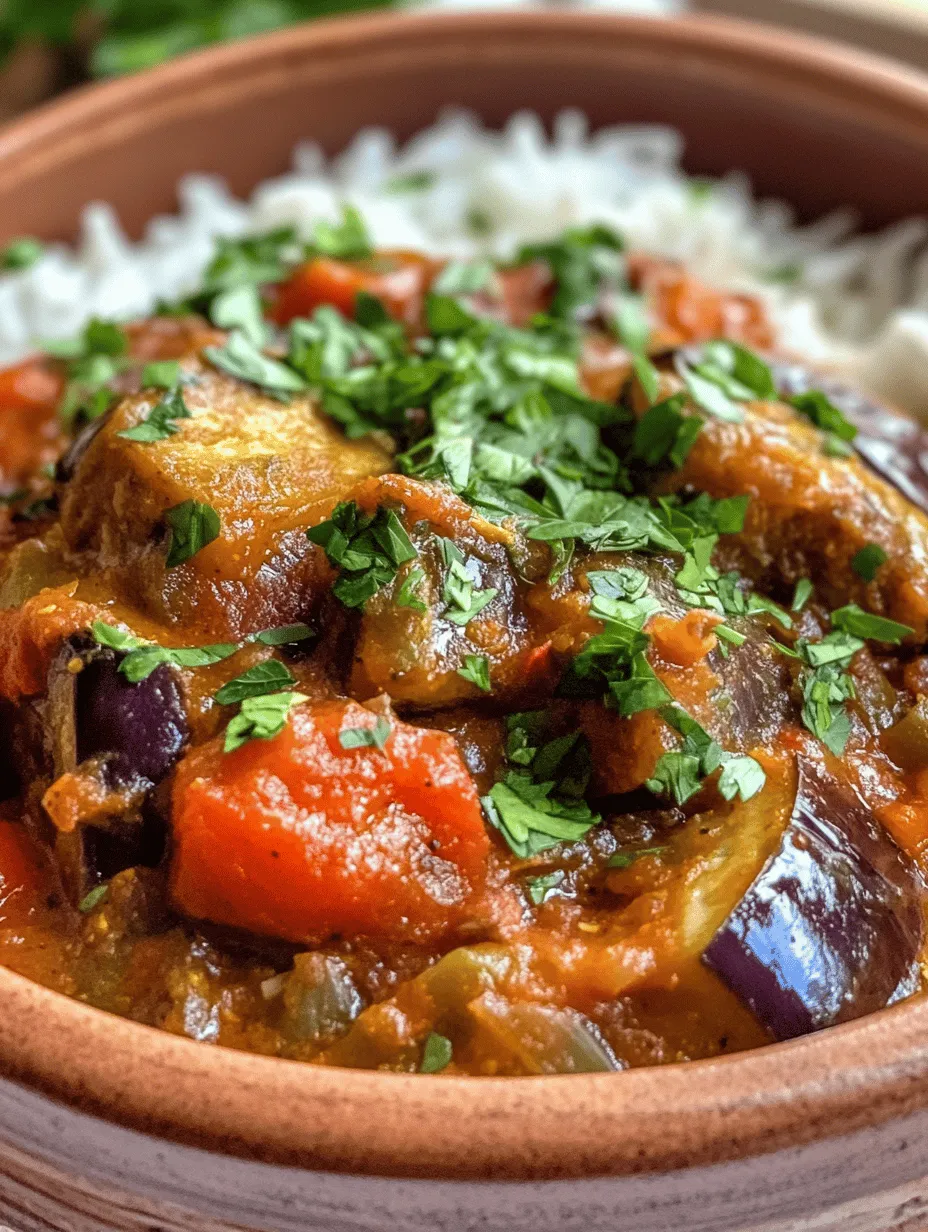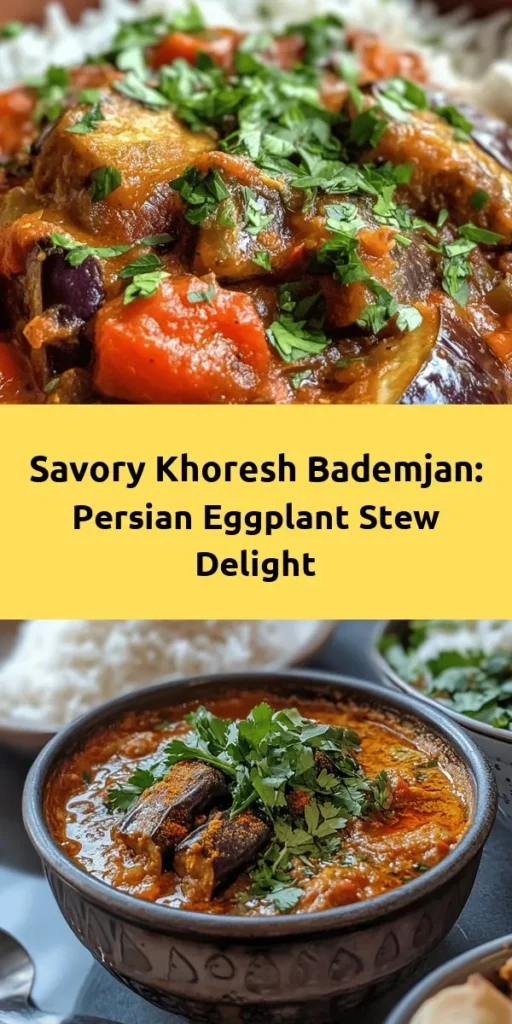Khoresh Bademjan, a beloved dish that embodies the essence of Persian cuisine, is a rich and aromatic stew featuring tender eggplants bathed in a savory sauce. This classic dish has been cherished for generations, and it represents the heart and soul of Iranian culinary traditions. With its vibrant flavors and inviting appearance, Khoresh Bademjan is not just a meal; it is a celebration of the rich agricultural heritage of Iran, where the bountiful land produces some of the finest ingredients.
Eggplants, the star of this dish, hold a special place in Persian cooking. Known as “bademjan” in Persian, these versatile vegetables are celebrated not only for their delicious taste but also for their nutritional benefits. They are a source of dietary fiber, vitamins, and antioxidants, making them a healthy choice for any meal. In Persian culture, eggplants are often used in various dishes, showcasing their adaptability and significance. Khoresh Bademjan highlights the eggplant’s ability to absorb flavors, creating a comforting dish that is both hearty and wholesome.
The flavor profile of Khoresh Bademjan is a delightful balance of savory, slightly sweet, and aromatic notes. The stew is characterized by its tender chunks of meat, typically lamb or beef, which meld beautifully with the eggplants and a medley of spices. The addition of turmeric, cinnamon, and cumin adds depth to the dish, resulting in a warm and inviting aroma that wafts through the kitchen as it simmers. This comforting nature of Khoresh Bademjan makes it a favorite among families and a staple at gatherings, where it is often served with fluffy basmati rice.
One of the remarkable aspects of Khoresh Bademjan is its versatility. While the traditional recipe incorporates meat, it can easily be adapted for vegetarians by substituting chickpeas or lentils for the meat, allowing everyone to enjoy its delightful flavors. This flexibility makes Khoresh Bademjan a popular choice for both meat lovers and those seeking plant-based options, ensuring that it can be enjoyed by all at the table.
Understanding the Ingredients of Khoresh Bademjan
To create a truly authentic Khoresh Bademjan, it is essential to understand the key ingredients that come together to form this delightful stew. Each component plays a vital role in developing the dish’s complex flavors and textures.
The Star of the Dish: Eggplants
Eggplants are undoubtedly the star ingredient of Khoresh Bademjan. They come in various types, including globe, Japanese, and Italian eggplants, each offering unique flavors and textures. For this recipe, the globe eggplant is commonly used due to its size and ability to absorb spices effectively. These vibrant purple vegetables are low in calories and rich in dietary fiber, making them an excellent choice for a healthy meal.
The preparation of eggplants is crucial for achieving the right flavor and texture in the stew. One common practice is to salt the eggplants before cooking. Salting helps to draw out excess moisture and bitterness, resulting in a creamier and more flavorful finished dish. This technique also aids in reducing the sponginess of the eggplant, ensuring that it holds its shape during cooking.
Choosing the Right Meat
When it comes to the choice of meat for Khoresh Bademjan, both lamb and beef are popular options. Lamb adds a rich and slightly gamey flavor that pairs beautifully with the spices and eggplants. Alternatively, beef provides a heartier texture and a robust taste. For those opting for a vegetarian version, chickpeas are an excellent alternative, providing protein and a satisfying bite that complements the eggplants.
Aromatic Spices: The Heart of Persian Flavor
The spices used in Khoresh Bademjan are essential for building the dish’s depth of flavor. Turmeric, often referred to as the golden spice, adds a warm hue and earthy taste to the stew. It is known for its anti-inflammatory properties and offers a myriad of health benefits. Cinnamon, with its sweet and spicy notes, brings warmth to the dish, while cumin introduces a nutty flavor that enhances the overall complexity of the stew.
These spices not only contribute to the taste but also connect the dish to the rich traditions of Persian cooking, where aromatic spices are a hallmark of many recipes. Their careful balance is what transforms Khoresh Bademjan from a simple eggplant and meat stew into a culinary masterpiece.
Fresh Ingredients: Building Flavor Profiles
In addition to eggplants and spices, fresh ingredients like onions, garlic, and tomatoes play an essential role in flavor development. Onions are often sautéed until golden brown, providing a sweet and caramelized base for the stew. Garlic adds a pungent aroma that elevates the dish’s overall profile, while tomatoes introduce acidity and freshness, balancing the richness of the meat and eggplant.
The quality of these fresh ingredients can make a significant difference in the final outcome of the dish. Opting for ripe, flavorful tomatoes and fresh garlic will enhance the overall taste and aroma of Khoresh Bademjan.
Optional Ingredients: Saffron and Potatoes
While the core ingredients of Khoresh Bademjan are crucial, there are optional ingredients that can elevate the dish further. Saffron, often referred to as “red gold,” is a luxurious spice that adds a unique aroma and flavor to the stew. Its vibrant color transforms the dish, making it visually appealing as well. Saffron is also known for its potential health benefits, including mood enhancement and digestive support.
Potatoes are another optional addition that some may choose to include in their Khoresh Bademjan. When cubed and added to the stew, they absorb the flavors of the broth and create a filling and satisfying element to the dish. This addition is particularly popular in some regional variations of Khoresh Bademjan, adding both texture and heartiness.
Step-by-Step Preparation of Khoresh Bademjan
Once you have gathered all the necessary ingredients, it’s time to roll up your sleeves and dive into the preparation of Khoresh Bademjan. This step-by-step guide will walk you through the essential techniques required to create this delicious dish.
Preparing the Eggplant
The first step in preparing Khoresh Bademjan is to handle the eggplants properly. Begin by selecting fresh, firm eggplants with smooth skin. The size and shape of the eggplants can vary, but look for ones that are free from blemishes and soft spots.
Salting the Eggplants: To reduce bitterness and enhance the flavor, you will want to salt the eggplants before cooking. Start by slicing the eggplants into cubes or rounds, depending on your preference. Place the cut eggplants in a colander and generously sprinkle them with salt. Allow them to sit for about 30 minutes, during which time they will release excess moisture and bitterness.
After the resting period, rinse the eggplants under cold water to remove the salt and any bitterness. Pat the eggplants dry with a clean kitchen towel or paper towels to ensure they are moisture-free, which will help achieve optimal texture during cooking.
Browning the Meat
Once the eggplants are prepared, it’s time to focus on the meat. Whether you are using lamb or beef, browning the meat is an essential step that develops depth of flavor.
Selecting and Preparing the Meat: Choose high-quality cuts of meat for the stew, as this will significantly impact the taste and texture. Cuts with a bit of marbling, such as lamb shoulder or beef chuck, are ideal, as they will become tender and flavorful during the cooking process.
Begin by heating a few tablespoons of oil in a large pot or Dutch oven over medium heat. Once the oil is hot, add the meat in batches, ensuring not to overcrowd the pot. Allow the meat to sear on all sides until it develops a rich, golden-brown crust. This browning process is crucial, as it creates a flavorful base for the stew.
Sautéing Onions and Garlic
With the meat browned, it’s time to build the aromatic base of the stew. In the same pot, add finely chopped onions and sauté them until they are translucent and golden. This process will take about 5-7 minutes. The sweet aroma of sautéing onions will fill the kitchen, signaling the start of something delicious.
Following the onions, add minced garlic and continue to sauté for an additional minute, just until fragrant. Be careful not to let the garlic burn, as this can impart a bitter taste to the dish.
Cooking the Stew: Building Flavors
Now that the meat, onions, and garlic are ready, it’s time to assemble the stew. Return the browned meat to the pot and add the prepared eggplants. Toss everything together to ensure the eggplants are well-coated with the flavorful mixture.
Next, add chopped tomatoes, along with the spices: turmeric, cinnamon, and cumin. Stir well to combine, allowing the spices to toast slightly in the pot, which will enhance their flavors. This step is essential for building the harmonious flavor profile that Khoresh Bademjan is known for.
Finally, add enough water or broth to cover the ingredients, and bring the mixture to a simmer. Once it reaches a gentle bubble, cover the pot and reduce the heat to low. Allow the stew to cook slowly, letting the flavors meld together for at least one to two hours. The longer it cooks, the more tender the meat and eggplants will become, creating a melt-in-your-mouth experience.
As the Khoresh Bademjan simmers, the kitchen will be filled with the tantalizing aroma of spices and savory goodness, inviting everyone to gather around the table in anticipation of a delicious meal.

Detailed Explanation of Spice Incorporation and Cooking Techniques
A successful Khoresh Bademjan is not just about combining ingredients; it’s about the careful layering of flavors through spices and cooking techniques. The key spices in this Persian eggplant stew include turmeric, cinnamon, and sometimes a hint of allspice. These spices should be incorporated at different stages of cooking to fully unlock their flavors.
Start by adding turmeric when sautéing the onions. This allows the spice to bloom in the hot oil, releasing its earthy aroma and vibrant color. After the onions turn golden, incorporate the diced tomatoes, allowing their acidity to balance the richness of the stew. For a touch of warmth, sprinkle in a pinch of cinnamon; its sweetness complements the natural bitterness of the eggplant. Stir these spices into the mixture and let them cook for a minute or two before adding the eggplants.
The Significance of Simmering for Tenderness and Flavor Melding
One of the most crucial steps in cooking Khoresh Bademjan is the simmering phase. After adding the eggplants and any optional ingredients, it’s essential to allow the stew to simmer gently. This low and slow cooking method helps the flavors meld together, resulting in a rich and complex sauce.
Simmering also tenderizes the eggplants, which can otherwise be spongy or tough if not cooked sufficiently. The longer you simmer, the more the spices infuse into the eggplants and meat, creating a harmonious blend. Aim for at least 30-45 minutes of simmering, but check periodically to ensure it doesn’t dry out—adding water as necessary.
Frying the Eggplants: Techniques for Achieving the Perfect Texture
Frying the eggplants is a vital step in preparing Khoresh Bademjan. The goal is to achieve a golden-brown exterior while keeping the inside creamy. To do this, start by slicing the eggplants into even pieces, about one inch thick. This uniformity ensures they cook evenly.
Before frying, consider salting the eggplant slices and letting them sit for about 30 minutes. This technique extracts excess moisture and bitterness, resulting in a more flavorful outcome. Rinse and pat dry the slices before frying to remove the salt and surface moisture.
Heat a generous amount of oil in a large skillet over medium-high heat. When the oil is hot, add the eggplants in batches, ensuring not to overcrowd the pan. This allows for even cooking and prevents steaming. Fry each side until golden brown, which should take about 4-5 minutes per side. Using a slotted spoon, transfer the fried eggplants to a paper towel-lined plate to absorb excess oil.
Best Practices for Frying to Avoid Excess Oil Absorption
To minimize oil absorption while frying eggplants, ensure the oil is sufficiently hot before adding the slices. If the oil is not hot enough, the eggplants will absorb more oil, resulting in a greasy texture. Additionally, you can use a combination of frying and baking for a healthier option. After frying for a few minutes to achieve a golden color, transfer the eggplants to a baking sheet and finish cooking in the oven at 375°F (190°C) for about 15-20 minutes.
Using a non-stick skillet can also help reduce the amount of oil needed, and opting for lighter oils such as canola or grapeseed can contribute to a less greasy dish.
Tips for Achieving Golden-Brown Eggplants
Achieving that perfect golden-brown color on your eggplants is essential for both flavor and presentation. Here are some tips to ensure success:
1. Pre-salting: As mentioned, salting the eggplants helps reduce moisture, allowing for better browning.
2. Don’t Overcrowd: Fry in batches to maintain the oil temperature and ensure even cooking.
3. Use the Right Temperature: Maintain a consistent medium-high heat without allowing the oil to smoke.
4. Patience is Key: Allow each side to cook undisturbed for a few minutes before flipping to develop a crust without breaking apart.
Incorporating Optional Ingredients: Enhancing the Dish’s Complexity
While the traditional Khoresh Bademjan is delicious as-is, you may wish to enhance the flavor profile by incorporating optional ingredients. One popular addition is fried potatoes, which can be added towards the end of the cooking process. The starchy potatoes absorb the sauce’s flavors while providing a satisfying texture contrast.
For a luxurious touch, consider adding a pinch of saffron. Simply steep the saffron threads in a tablespoon of hot water or broth before adding it to the stew. This will not only enhance the flavor but also impart a beautiful golden hue to the dish.
The Impact of Adding Fried Potatoes and Saffron on Flavor and Presentation
Fried potatoes add a delightful texture and a pleasing sweetness to Khoresh Bademjan. They can be cut into thin strips or cubes and fried until crispy before being added to the stew. This not only enhances the flavor but also provides a lovely visual contrast against the rich, deep colors of the stew.
Saffron, revered in Persian cuisine, elevates the dish both in taste and appearance. Its floral notes harmonize beautifully with the eggplant and meat, while its vibrant color makes for an appealing presentation. When served, the dish takes on a luxurious appearance, especially when garnished with fresh herbs.
Final Cooking and Serving Suggestions for Khoresh Bademjan
Combining cooked ingredients is crucial to achieving a harmonious blend of flavors in Khoresh Bademjan. Once all components are ready, gently fold the fried eggplants and any optional ingredients into the simmering sauce. Allow everything to simmer together for an additional 15 minutes. This final simmering stage is crucial for flavor development, as it allows the eggplants to soak up the sauce while melding all the flavors together.
When it comes to serving Khoresh Bademjan, traditional accompaniments are essential. Basmati rice is a must, providing a fluffy base that complements the rich stew. To elevate the presentation, serve the stew over a mound of rice, garnished with fresh herbs, such as parsley or cilantro. The herbs not only add a pop of color but also enhance the overall flavor profile.
Importance of Serving with Basmati Rice and Garnishing with Fresh Herbs
Basmati rice is the perfect canvas for Khoresh Bademjan, soaking up the stew’s flavors while providing a contrasting texture. The fluffy grains of rice create a satisfying foundation, allowing the rich stew to shine.
Garnishing with fresh herbs adds brightness and freshness, cutting through the richness of the dish. A sprinkle of toasted almonds or walnuts can also add a crunchy element and visual appeal.
Cultural Context and Variations of Khoresh Bademjan
Khoresh Bademjan is more than just a dish; it’s a part of Persian culture and history. Traditionally served during family gatherings and significant celebrations, it embodies the warmth and hospitality of Persian cuisine.
Regional variations abound, with some areas of Iran adding different spices or incorporating meat types like lamb or chicken in place of beef. In the north, you might find a sweeter version, whereas southern regions may use a spicier blend of spices. Each variation tells a story, connecting families to their heritage through shared recipes and cooking techniques.
Personal Anecdotes or Stories that Connect Families Through This Dish
Many families have their own unique take on Khoresh Bademjan, often passed down through generations. For instance, a mother might share her secret ingredient or technique learned from her grandmother, creating a familial bond through the act of cooking. These stories often highlight the importance of meals in bringing loved ones together, creating memories that last a lifetime.
Conclusion: Embracing the Flavors of Khoresh Bademjan
In conclusion, Khoresh Bademjan is a dish steeped in tradition, rich in flavor, and deeply comforting. Its layers of spices, tender eggplants, and the warmth of family gatherings make it a cherished meal in Persian households. This recipe invites you to explore the joys of Persian cooking and to share this delightful dish with your loved ones.
As you embark on your culinary journey, remember that the heart of cooking lies in the love and care you put into each dish. Embrace the flavors of Khoresh Bademjan, and may it bring warmth and joy to your table, just as it has for countless families before you.



